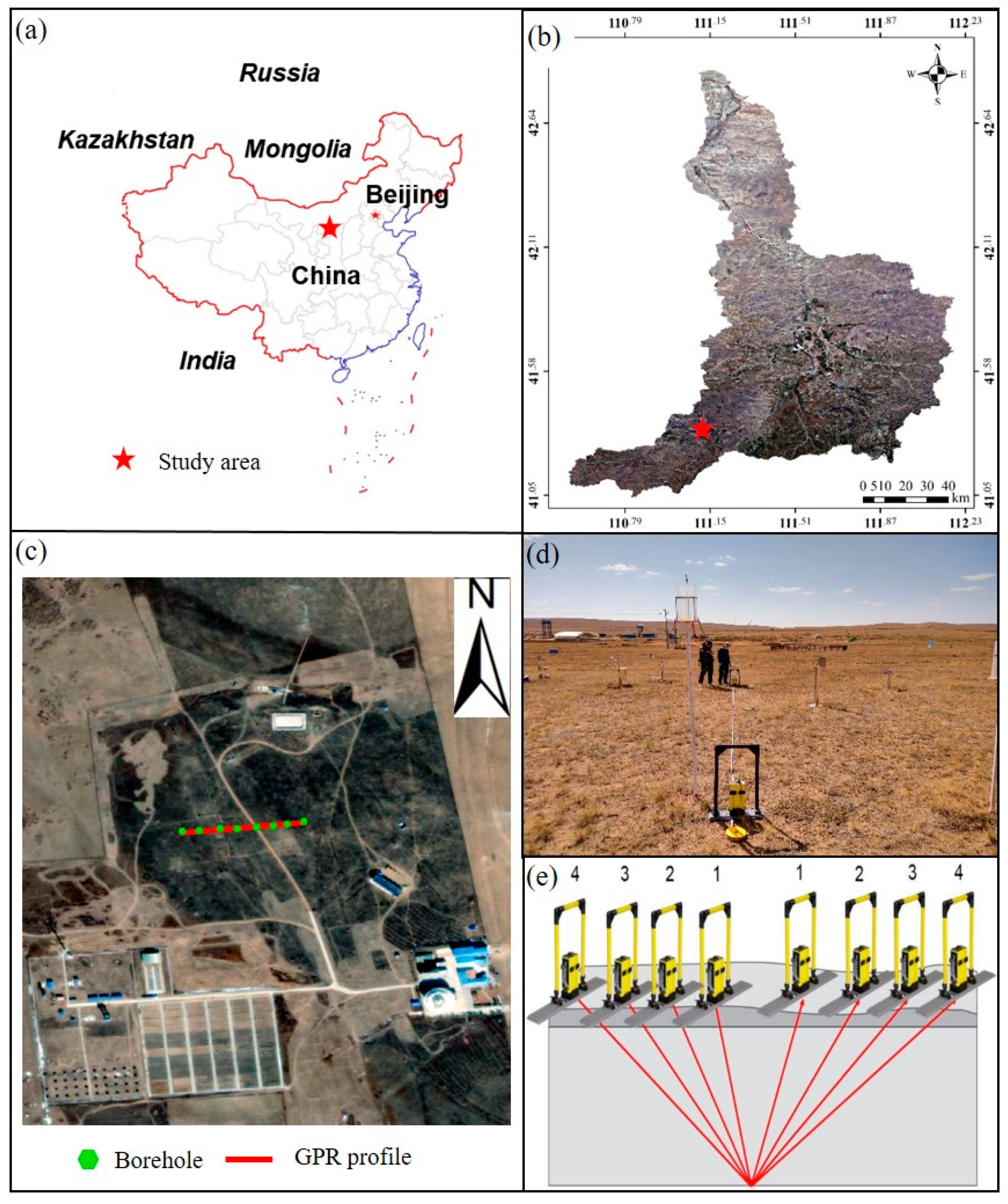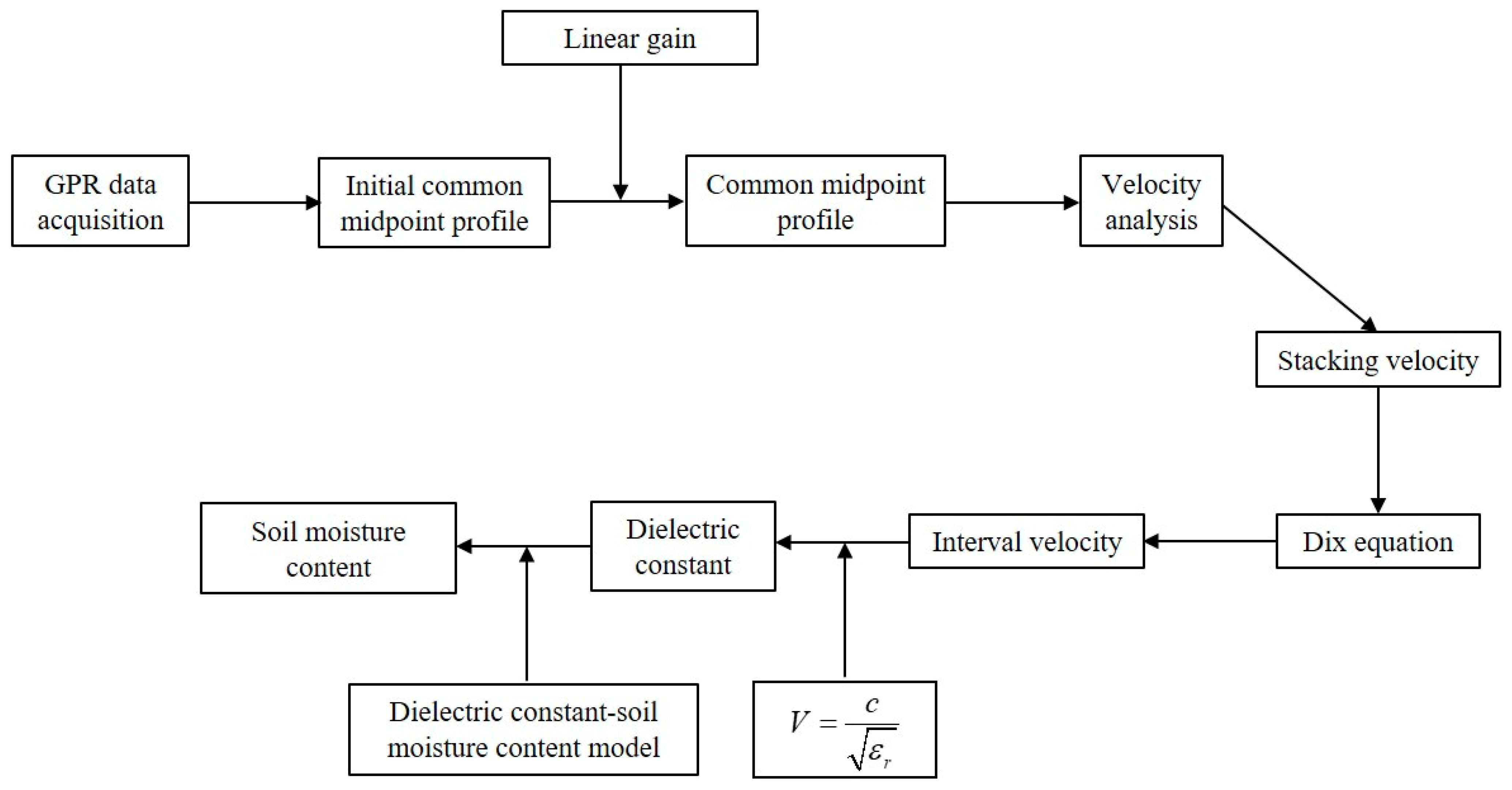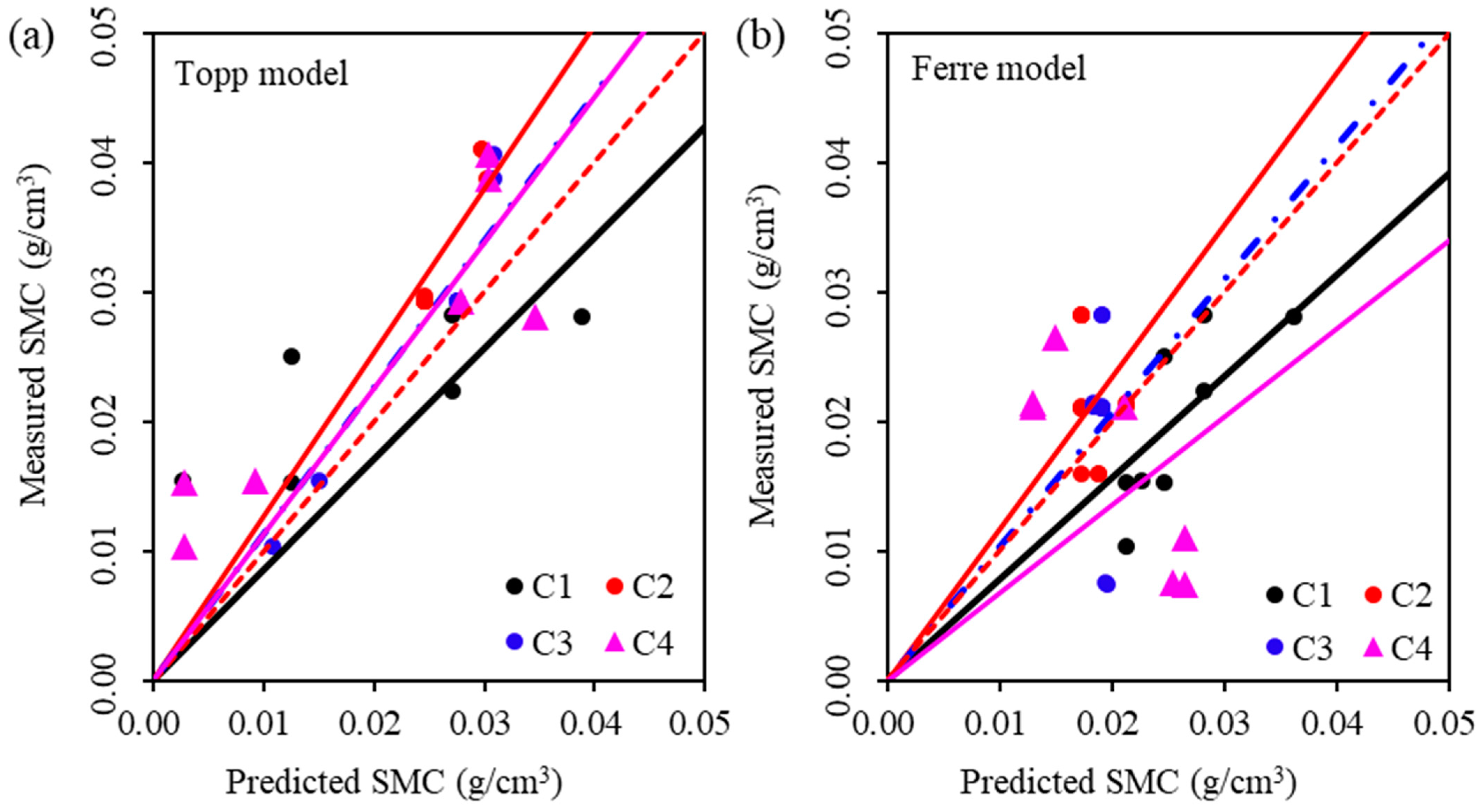Estimation of the Soil Moisture Content in a Desert Steppe on the Mongolian Plateau Based on Ground-Penetrating Radar
Abstract
1. Introduction
2. Materials and Methods
Overview of Study Area and Data Acquisition
3. Methods
3.1. Ground Radar Observations and Data Interpretation
3.2. Mixed-Media Model
3.3. Soil Sample Analysis
3.3.1. Soil Particle Size and Mass Moisture Content
3.3.2. SMC of Soil Samples
3.4. Cross-Validation and Error Analysis
3.4.1. Cross-Validation
3.4.2. Error Analysis
4. Results
4.1. Soil Particle Size Analysis
4.2. Prediction of the SMC Using Existing Mixed-Media Models
4.3. Cross-Validation Calibration of Mixed-Media Model Parameters
5. Discussion
6. Conclusions
Author Contributions
Funding
Institutional Review Board Statement
Informed Consent Statement
Data Availability Statement
Conflicts of Interest
References
- Abdulraheem, M.I.; Chen, H.; Li, L.; Moshood, A.Y.; Zhang, W.; Xiong, Y.; Zhang, Y.; Taiwo, L.B.; Farooque, A.A.; Hu, J. Recent Advances in Dielectric Properties-Based Soil Water Content Measurements. Remote Sens. 2024, 16, 1328. [Google Scholar] [CrossRef]
- Zhang, M.H.; Feng, X.; Bano, M.; Liu, C.; Liu, Q.; Wang, X. Soil water content estimation by using ground penetrating radar data full waveform inversion with grey wolf optimizer algorithm. Vadose Zone J. 2024, e20379. [Google Scholar] [CrossRef]
- Lei, L.; Zheng, J.; Li, S.; Yang, L.; Wang, W.; Zhang, F.; Zhang, B. Soil Hydrological Properties’ Response to Long-Term Grazing on a Desert Steppe in Inner Mongolia. Sustainability 2023, 15, 16256. [Google Scholar] [CrossRef]
- Rasheed, M.W.; Tang, J.; Sarwar, A.; Shah, S.; Saddique, N.; Khan, M.U.; Imran Khan, M.; Nawaz, S.; Shamshiri, R.R.; Aziz, M. Soil Moisture Measuring Techniques and Factors Affecting the Moisture Dynamics: A Comprehensive Review. Sustainability 2022, 14, 11538. [Google Scholar] [CrossRef]
- Lu, Q.; Liu, K.; Zeng, Z.; Liu, S.; Li, R.; Xia, L.; Guo, S.; Li, Z. Estimation of the Soil Water Content Using the Early Time Signal of Ground-Penetrating Radar in Heterogeneous Soil. Remote Sens. 2023, 15, 3026. [Google Scholar] [CrossRef]
- Kawamura, K.; Akiyama, T.; Yokota, H.; Tsutsumi, M.; Yasuda, T.; Watanabe, O.; Wang, G.; Wang, S. Monitoring of forage conditions with MODIS imagery in the Xilingol steppe, Inner Mongolia. Int. J. Remote Sens. 2005, 26, 1423–1436. [Google Scholar] [CrossRef]
- Wang, X.; Dong, J.; Baoyin, T.; Bao, Y. Estimation and Climate Factor Contribution of Aboveground Biomass in Inner Mongolia’s Typical/Desert Steppes. Sustainability 2019, 11, 6559. [Google Scholar] [CrossRef]
- Wang, B.; Wu, L.; Chen, D.; Wu, Y.; Hu, S.; Li, L.; Bai, Y. Grazing simplifies soil micro-food webs and decouples their relationships with ecosystem functions in grasslands. Glob. Chang. Biol. 2020, 26, 960–970. [Google Scholar] [CrossRef] [PubMed]
- Zhang, R.; Wang, Z.; Han, G.; Schellenberg, M.P.; Wu, Q.; Gu, C. Grazing induced changes in plant diversity is a critical factor controlling grassland productivity in the Desert Steppe, Northern China. Agric. Ecosyst. Environ. 2018, 265, 73–83. [Google Scholar] [CrossRef]
- Seneviratne, S.I.; Corti, T.; Davin, E.L.; Hirschi, M.; Jaeger, E.B.; Lehner, I.; Orlowsky, B.; Teuling, A.J. Soil moisture–climate interactions: A review. Atmos. Res. 2010, 99, 583–600. [Google Scholar]
- Liu, Y.; Zhang, X.; Wang, Z. Soil moisture and livestock production in desert steppe regions of northwest China: Implications for sustainable management. Agric. Water Manag. 2020, 233, 106079. [Google Scholar]
- Zhang, H.; Wang, W.; Li, F. Soil moisture-based vegetation restoration techniques in desert steppe regions of Inner Mongolia, China. Ecol. Eng. 2019, 135, 100–108. [Google Scholar]
- Wang, L.; Li, Z.; Zhang, Y. A soil moisture-based framework for water resource management in desert steppe regions. Water Resour. Manag. 2016, 30, 5189–5204. [Google Scholar]
- Reichle, R.H.; Koster, R.D.; Liu, P.; Mahanama, S.P.P.; Njoku, E.G.; Owe, M. Assessment of the SMAP level-4 surface and root-zone soil moisture product using in situ measurements. J. Hydrometeorol. 2017, 18, 2921–2945. [Google Scholar] [CrossRef]
- Tran, A.P.; Vanclooster, M.; Lambot, S. Improving soil moisture profile reconstruction from ground-penetrating radar data: A maximum likelihood ensemble filter approach. Hydrol. Earth Syst. Sci. 2013, 17, 2543–2556. [Google Scholar] [CrossRef]
- Binley, A.; Hubbard, S.S.; Huisman, J.A.; Revil, A.; Robinson, D.A.; Singha, K.; Slater, L.D. The emergence of hydrogeophysics for improved understanding of subsurface processes over multiple scales. Water Resour. Res. 2015, 51, 3837–3866. [Google Scholar] [CrossRef]
- Piroddi, L.; Rassu, M. Application of GPR Prospection to Unveil Historical Stratification inside Monumental Buildings: The Case of San Leonardo de Siete Fuentes in Santu Lussurgiu, Sardinia, Italy. Land 2023, 12, 590. [Google Scholar] [CrossRef]
- Cui, F.; Bao, J.; Cao, Z.; Li, L.; Zheng, Q. Soil hydraulic parameters estimation using ground penetrating radar data via ensemble smoother with multiple data assimilation. J. Hydrol. 2020, 583, 124552. [Google Scholar] [CrossRef]
- Paz, C.; Alcalá, F.J.; Carvalho, J.; Ribeiro, L. Current uses of ground penetrating radar in groundwater-dependent ecosystems research. Sci. Total Environ. 2017, 595, 868–885. [Google Scholar] [CrossRef]
- Tran, A.P.; Vanclooster, M.; Zupanski, M.; Lambot, S. Joint estimation of soil moisture profile and hydraulic parameters by groundpenetrating radar data assimilation with maximum likelihood ensemble filter. Water Resour. Res. 2014, 50, 3131–3146. [Google Scholar] [CrossRef]
- Zajícová, K.; Chuman, T. Application of ground penetrating radar methods in soil studies: A review. Geoderma 2019, 343, 116–129. [Google Scholar] [CrossRef]
- Huisman, J.A.; Hubbard, S.S.; Redman, J.D.; Annan, A.P. Measuring soil water content with ground penetrating radar: A review. Vadose Zone J. 2003, 2, 476–491. [Google Scholar] [CrossRef]
- Shen, H.; Li, X.; Duan, R.; Zhao, Y.; Zhao, J.; Che, H.; Liu, G.; Xue, Z.; Yan, C.; Liu, J.; et al. Quality evaluation of ground improvement by deep cement mixing piles via ground-penetrating radar. Nat. Commun. 2023, 14, 3448. [Google Scholar] [CrossRef] [PubMed]
- Vereecken, H.; Huisman, J.A.; Bogena, H.; Vanderborght, J.; Vrugt, J.A.; Hopmans, J.W. On the value of soil moisture measurements in vadose zone hydrology: A review: Soil moisture and hydrology. Water Resour. Res. 2008, 44, W00D06. [Google Scholar] [CrossRef]
- Vereecken, H.; Huisman, J.A.; Pachepsky, Y.; Montzka, C.; van der Kruk, J.; Bogena, H.; Weihermüller, L.; Herbst, M.; Martinez, G.; Vanderborght, J. On the spatiotemporal dynamics of soil moisture at the field scale. J. Hydrol. 2014, 516, 76–96. [Google Scholar] [CrossRef]
- Eppstein, M.J.; Dougherty, D.E. Efficient three-dimensional data inversion: Soil characterization and moisture monitoring from cross-well ground penetrating radar at a Vermont test site. Water Resour. Res. 1998, 34, 1889–1900. [Google Scholar] [CrossRef]
- Zou, C.; Zhang, S.; Jiang, X.; Chen, F. Monitoring and characterization of water infiltration in soil unsaturated zone through an integrated geophysical approach. Catena 2023, 230, 107243. [Google Scholar] [CrossRef]
- Cheng, Q.; Su, Q.; Binley, A.; Liu, J.; Zhang, Z.; Chen, X. Estimation of surface soil moisture by a multi-elevation UAV-based ground penetrating radar. Water Resour. Res. 2023, 59, e2022WR032621. [Google Scholar] [CrossRef]
- Grote, K.; Hubbard, S.; Rubin, Y. Field-scale estimation of volumetric water content using ground-penetrating radar ground wave techniques. Water Resour. Res. 2003, 39, 1321. [Google Scholar] [CrossRef]
- Liu, X.; Chen, J.; Butnor, J.R.; Qin, G.; Cui, X.; Fan, B.; Lin, H.; Guo, L. Noninvasive 2D and 3D mapping of root zone soil moisture through the detection of coarse roots with ground-penetrating radar. Water Resour. Res. 2020, 56, e2019WR026930. [Google Scholar] [CrossRef]
- Jin, J.; Liu, T.; Liao, Z.; Wang, M.; Wang, Z. Interaction between intermittent river and groundwater in arid and semiarid basin considering the influence of evaporation on isotopic compositions. J. Hydrol-Reg. Stud. 2024, 54, 101876. [Google Scholar] [CrossRef]
- Babaeian, E.; Sadeghi, M.; Jones, S.B.; Montzka, C.; Vereecken, H.; Tuller, M. Ground, proximal, and satellite remote sensing of soil moisture. Rev. Geophy. 2019, 57, 530–616. [Google Scholar] [CrossRef]
- Li, Z.; Zeng, Z.; Xiong, H.; Lu, Q.; An, B.; Yan, J.; Li, R.; Xia, L.; Wang, H.; Liu, K. Study on Rapid Inversion of Soil Water Content from Ground-Penetrating Radar Data Based on Deep Learning. Remote Sens. 2023, 15, 1906. [Google Scholar] [CrossRef]
- Yuan, W.; Liu, S.; Zhao, Q.; Deng, L.; Lu, Q.; Pan, L.; Li, Z. Application of Ground-Penetrating Radar with the Logging Data Constraint in the Detection of Fractured Rock Mass in Dazu Rock Carvings, Chongqing, China. Remote Sens. 2023, 15, 4452. [Google Scholar] [CrossRef]
- Overmeeren, R.A.V.; Sariowan, S.V.; Gehrels, J.C. Ground penetrating radar for determining volumetric soil water content; results of comparative measurements at two test sites. J. Hydrol. 1997, 197, 316–338. [Google Scholar] [CrossRef]
- Greaves, R.J.; Lesmes, D.P.; Lee, J.M.; Toksoz, M.N. Velocity variations and water content estimated from multi-offset, ground-penetrating radar. Geophysics 1996, 61, 683–695. [Google Scholar] [CrossRef]
- Annan, A.P. Ground-Penetrating Radar. In Near-Surface Geophysics; Butler, D.K., Ed.; Society of Exploration Geophysicists: Houston, TX, USA, 2005; Volume 13. [Google Scholar] [CrossRef]
- Steelman, C.M.; Endres, A.L.; Jones, J.P. High-resolution ground-penetrating radar monitoring of soil moisture dynamics: Field results, interpretation, and comparison with unsaturated flow model. Water Resour. Res. 2012, 48, W09538. [Google Scholar] [CrossRef]
- Suman, S.; Srivastava, P.K.; Pandey, D.K.; Prasad, R.; Mall, R.K.; O’Neill, P. Comparison of soil dielectric mixing models for soil moisture retrieval using SMAP brightness temperature over croplands in India. J. Hydrol. 2021, 602, 126673. [Google Scholar] [CrossRef]
- Steelman, C.M.; Endres, A.L. Comparison of petrophysical relationships for soil moisture estimation using GPR ground waves. Vadose Zone J. 2011, 10, 270–285. [Google Scholar] [CrossRef]
- Weiler, K.W.; Steenhuis, T.S.; Boll, J.; Kung, K.J.S. Comparison of Ground Penetrating Radar and Time-Domain Reflectometry as Soil Water Sensors. Soil Sci. Soc. Am. J. 1998, 62, 1237–1239. [Google Scholar] [CrossRef]
- Černý, R. Time-domain reflectometry method and its application for measuring moisture content in porous materials: A review. Measurement 2009, 42, 329–336. [Google Scholar] [CrossRef]
- Topp, G.C.; Davis, J.L.; Annan, A.P. Electromagnetic determination of soil water content: Measurements in coaxial transmissions lines. Water Resour. Res. 1980, 16, 574–582. [Google Scholar] [CrossRef]
- Roth, C.H.; Malicki, M.A.; Plagge, R. Empirical evaluation of the relationship between soil dielectric constant and volumetric water content as the basis for calibrating soil moisture measurements by TDR. Soil Sci. 1992, 43, 1–13. [Google Scholar] [CrossRef]
- Ferre, P.A.; Rudolph, D.L.; Kachanoski, R.G. Spatial averaging of water content by time domain reflectometry: Implications for twin rod probes with and without dielectric coatings. Water Resour. Res. 1996, 32, 271–279. [Google Scholar] [CrossRef]
- Yang, Z.; Miao, P.; Zheng, Y.; Guo, J. Impacts of Grazing on Vegetation and Soil Physicochemical Properties in Northern Yinshan Mountain Grasslands. Sustainability 2023, 15, 16028. [Google Scholar] [CrossRef]
- Akaike, H. Information theory as an extension of the maximum likelihood principle. In Proceedings of the Second International Symposium on Information Theory, Tsahkadsor, Armenia, 2–8 September 1971; Petrov, B.N., Csaki, F., Eds.; Akademiai Kiado: Budapest, Hungary, 1973; pp. 267–281. [Google Scholar]
- Schwarz, G. Estimating the Dimension of a Model. Ann. Stat. 1978, 6, 461–464. [Google Scholar] [CrossRef]
- Enemark, T.; Peeters, L.J.M.; Mallants, D.; Batelaan, O. Hydrogeological conceptual model building and testing: A review. J. Hydrol. 2019, 569, 310–329. [Google Scholar] [CrossRef]
- Mahmoudzadeh Ardekani, M.R. Off-and on-ground GPR techniques for field-scale soil moisture mapping. Geoderma 2013, 200–201, 55–66. [Google Scholar] [CrossRef]
- Li, Y.; Shao, M.; Li, X. Dynamics of soil moisture and its relationship with vegetation cover in a desert steppe of Inner Mongolia, China. J. Arid Environ. 2018, 155, 47–55. [Google Scholar]
- Lei, T.; Gu, Q.; Guo, X.; Ma, J.; Zhang, Y.; Sun, X. Urease activity and urea hydrolysis rate under coupling effects of moisture content, temperature, and nitrogen application rate. Int. J. Agric. Biol. Eng. 2018, 11, 132–138. [Google Scholar] [CrossRef]
- Leong, Z.X.; Zhu, T. Direct velocity inversion of ground penetrating radar data using GPRNet. J. Geophys. Res-Sol. Earth 2021, 126, e2020JB021047. [Google Scholar] [CrossRef]
- Cao, Q.; Song, X.; Wu, H.; Gao, L.; Zhang, G. Mapping the response of volumetric soil water content to an intense rainfall event at the field scale using GPR. J. Hydrol. 2020, 583, 124605. [Google Scholar] [CrossRef]
- Giroux, B.; Chouteau, M. Quantitative analysis of water-content estimation errors using ground-penetrating radar data and a low-loss approximation. Geophysics 2010, 75, WA241–WA249. [Google Scholar] [CrossRef]
- Ranalli, D.; Scozzafava, M.; Tallin, M.; Colagrande, S. GPR signal attenuation vs. depth on damaged flexible road pavements. In Proceedings of the International Workshop on Advanced Ground Penetrating Radar, IEEE, Naples, Italy, 27–29 June 2007. [Google Scholar]
- van der Kruk, J.; Streich, R.; Green, A.G. Joint dispersion inversion of broadside and endfire CMP georadar data for properties of a thin-surface waveguide. Geophysics 2006, 71, K19–K29. [Google Scholar] [CrossRef]
- van der Kruk, J.; Steelman, C.M.; Endres, A.L.; Vereecken, H. Dispersion inversion of electromagnetic pulse propagation within freezing and thawing soil waveguides. Geophys. Res. Lett. 2009, 36, L18503. [Google Scholar] [CrossRef]
- Haruzi, P.; Schmäck, J.; Zhou, Z.; van der Kruk, J.; Vereecken, H.; Vanderborght, J.; Klotzsche, A. Detection of tracer plumes using full-waveform inversion of time-lapse ground penetrating radar data: A numerical study in a high-resolution aquifer model. Water Resour. Res. 2022, 58, e2021WR030110. [Google Scholar] [CrossRef]
- Bayarri, V.; Prada, A.; García, F.; De Las Heras, C.; Fatás, P. Remote Sensing and Environmental Monitoring Analysis of Pigment Migrations in Cave of Altamira’s Prehistoric Paintings. Remote Sens. 2024, 16, 2099. [Google Scholar] [CrossRef]
- Romano, G.; Capozzoli, L.; Abate, N.; De Girolamo, M.; Liso, I.S.; Patella, D.; Parise, M. An Integrated Geophysical and Unmanned Aerial Systems Surveys for Multi-Sensory, Multi-Scale and Multi-Resolution Cave Detection: The Gravaglione Site (Canale di Pirro Polje, Apulia). Remote Sens. 2023, 15, 3820. [Google Scholar] [CrossRef]






| Category | Boreholes Used for Calibration | Boreholes Used for Verification |
|---|---|---|
| C1 | Z1/Z2/Z3/Z4/Z5 | Z6/Z7/Z8 |
| C2 | Z4/Z5/Z6/Z7/Z8 | Z1/Z2/Z3 |
| C3 | Z3/Z4/Z5/Z6/Z7 | Z1/Z2/Z8 |
| C4 | Z2/Z3/Z4/Z5/Z6/Z7 | Z1/Z7/Z8 |
| Depth (cm) | Silty Soil | Silt | Sand Grains | Lithology | |
|---|---|---|---|---|---|
| 0.01–2 µm (%) | 2–20 µm (%) | 20–200 µm (%) | 200–2000 µm (%) | ||
| 0–20 | 2.13 | 19.77 | 72.85 | 5.26 | Fine sand |
| 20–40 | 2.65 | 22.13 | 70.21 | 5.01 | Fine sand |
| 40–60 | 3.19 | 22.5 | 64.12 | 10.19 | Fine sand |
| 60–80 | 3.41 | 24.02 | 57.44 | 15.13 | Fine sand |
| 80–100 | 3.3 | 23.54 | 44.83 | 28.33 | Fine sand |
| 100–120 | 3.45 | 26.61 | 46.66 | 23.28 | Fine sand |
| 120–140 | 2.95 | 27.43 | 45.67 | 23.95 | Fine sand |
| 140–160 | 2.72 | 26.51 | 55.9 | 14.87 | Fine sand |
| 160–180 | 3.4 | 28.71 | 49.06 | 18.83 | Fine sand |
| 180–200 | 3.71 | 34.85 | 47.8 | 13.64 | Fine sand |
| Mean | 3.09 | 25.607 | 55.454 | 15.849 | Fine sand |
| Model | R2 | RMSE (g/cm3) | MAPE (%) | AIC | BIC |
|---|---|---|---|---|---|
| Topp | 0.566 | 0.0091 | 25.86 | −246.004 | −240.821 |
| Roth | 0.566 | 0.0054 | 19.01 | −274.411 | −269.227 |
| Ferre | −1.981 | 0.0208 | 76.24 | −205.248 | −202.657 |
| Category | Topp Model | Ferre Model | ||
|---|---|---|---|---|
| Fitting Model | R2 | Fitting Model | R2 | |
| C1 | θc = −0.8549 + 0.1789εr + 0.2097εr2 − 0.057εr3 | −2.4 | θc = −0.1419 + 0.1053 | 0.5874 |
| C2 | θc = 3.2608 − 3.9103εr + 1.5519εr2 − 0.02056εr3 | 0.8381 | θc = −0.0458 + 0.039 | −0.346 |
| C3 | θc = −0.4696 + 0.131εr + 0.0976εr2 − 0.0287εr3 | 0.9028 | θc = 0.0313 − 0.0076 | −0.065 |
| C4 | θc = −0.7187 + 0.1746εr + 0.1646εr2 − 0.0467εr3 | 0.5285 | θc = 0.1523 − 0.0812 | −1.435 |
| Model | Fitting Model | R2 | RMSE (g/cm3) | MAPE (%) | AIC | BIC |
|---|---|---|---|---|---|---|
| Topp | θc = −0.4696 + 0.131εr + 0.0976εr2 − 0.0287εr3 | 0.6527 | 0.005 | 14.34 | −279.30 | −274.12 |
| Ferre | θc = −0.1419 + 0.1053 | 0.5449 | 0.006 | 20.56 | −275.43 | −272.83 |
Disclaimer/Publisher’s Note: The statements, opinions and data contained in all publications are solely those of the individual author(s) and contributor(s) and not of MDPI and/or the editor(s). MDPI and/or the editor(s) disclaim responsibility for any injury to people or property resulting from any ideas, methods, instructions or products referred to in the content. |
© 2024 by the authors. Licensee MDPI, Basel, Switzerland. This article is an open access article distributed under the terms and conditions of the Creative Commons Attribution (CC BY) license (https://creativecommons.org/licenses/by/4.0/).
Share and Cite
Li, K.; Liao, Z.; Ji, G.; Liu, T.; Yu, X.; Jiao, R. Estimation of the Soil Moisture Content in a Desert Steppe on the Mongolian Plateau Based on Ground-Penetrating Radar. Sustainability 2024, 16, 8558. https://doi.org/10.3390/su16198558
Li K, Liao Z, Ji G, Liu T, Yu X, Jiao R. Estimation of the Soil Moisture Content in a Desert Steppe on the Mongolian Plateau Based on Ground-Penetrating Radar. Sustainability. 2024; 16(19):8558. https://doi.org/10.3390/su16198558
Chicago/Turabian StyleLi, Kaixuan, Zilong Liao, Gang Ji, Tiejun Liu, Xiangqian Yu, and Rui Jiao. 2024. "Estimation of the Soil Moisture Content in a Desert Steppe on the Mongolian Plateau Based on Ground-Penetrating Radar" Sustainability 16, no. 19: 8558. https://doi.org/10.3390/su16198558
APA StyleLi, K., Liao, Z., Ji, G., Liu, T., Yu, X., & Jiao, R. (2024). Estimation of the Soil Moisture Content in a Desert Steppe on the Mongolian Plateau Based on Ground-Penetrating Radar. Sustainability, 16(19), 8558. https://doi.org/10.3390/su16198558





